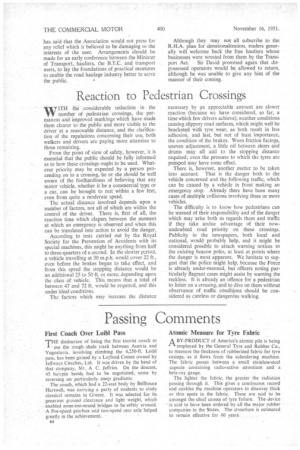Reaction to Pedestrian Crossings
Page 38

If you've noticed an error in this article please click here to report it so we can fix it.
WITH the considerable reduction in the V V number of pedestrian crossings, the permanent and improved markings which have made them clearer to the public and more visible to the driver at a reasonable distance, and the clarification of the regulations concerning their use, both walkers and drivers are paying more attention to those remaining.
From the point of view of safety, however, it is essential that the public should be fully informed as to how these crossings ought to be used. Whatever priority may be expected by a person proceeding on to a crossing. he or she should be well aware of the foolhardiness of believing that any motor vehicle, whether it be a commercial type or a car, can be brought to rest within a few feet, even from quite a moderate speed.
The actual distance involved depends upon a number of factors, not all of Which are within the control of the driver. There is, first of all, the reaction time which elapses between the moment at which an emergency is observed and When this can be translated into action to avoid the danger.
According to tests carried out by the Royal Society for the Prevention of Accidents with its special machines, this might be anything from half to three-quarters of a second. In the shorter period, a vehicle travelling at 30 m.p.h. would cover 22 ft., even before the brakes began to take effect, and from this speed the stopping distance would be an additional 25 to 50 ft. or more, depending upon the class of vehicle. This means that a total of between 47 and 72 ft. would be required, and this under ideal conditions.
The factors which may increase the distance necessary by an appreciable amount are slower reaction (because we have considered, so far, a time which few drivers achieve), weather conditions causing slippery road surfaces, which might well be bracketed with tyre wear, as both result in less adhesion, and last, but not of least importance, the condition of the brakes. Worn friction facings, uneven adjustment, a little oil between shoes and drums may all add to the stopping distance required; even the pressure to which the tyres are pumped may have some effect.
There is, however, another matter to be taken into account. That is the danger both to the vehicle concerned and the following traffic, which can be caused by a vehicle in front making an emergency stop. Already there have been many cases of multiple collisions involving three or more vehicles.
The difficulty is to know how pedestrians can be warned of their responsibility and of the danger which may arise both as regards them and traffic if they take undue advantage of their nowundoubted road priority on these crossings. Publicity in the newspapers, both local and national, would probably Wp, and it might be considered possible to attach warning notices to the existing beacon poles, at least at points where the danger is most apparent. We hesitate to suggest that the police might help, because the Force is already under-manned, but officers noting particularly flagrant cases might assist by warning the reckless. It is already an offence for a pedestrian to loiter on a crossing, and to dive on them without observance of traffic conditions should be considered as careless or dangerous walking.




































































































